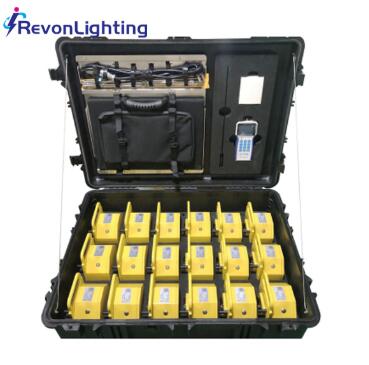Portable helipad lights are revolutionizing the aviation industry by providing versatile, reliable, and efficient lighting solutions for temporary and permanent helipad operations. Whether for emergency medical services, military operations, or remote infrastructure projects, these lights ensure safe and visible landing zones under varying conditions. This article explores the key features, benefits, and applications of portable helipad lights, highlighting their vital role in modern aviation.
Understanding Portable Helipad Lights
Portable helipad lights are compact, battery-operated lighting systems designed for rapid deployment and easy transport. They are engineered to provide clear and consistent illumination, enabling pilots to identify and land safely on helipads, even in low-visibility conditions. These lights are ideal for temporary setups and situations where traditional fixed lighting systems are impractical.
Key Features of Portable Helipad Lights
Ease of Deployment: Lightweight and compact designs make portable helipad lights easy to set up and transport to various locations.

Battery-Powered Operation: Built-in rechargeable batteries provide reliable power, eliminating the need for external electricity sources.
Weather Resistance: Designed to withstand harsh environmental conditions, these lights function reliably in rain, wind, and extreme temperatures.
High Visibility: Equipped with powerful LEDs, they ensure optimal visibility for pilots, complying with aviation safety standards.
Wireless Control Options: Many models include remote control capabilities, allowing operators to adjust light settings from a distance.
| Portable Helipad Lights |
| Portable Helipad Light |
Benefits of Portable Helipad Lights
Flexibility: Portable helipad lights can be deployed in diverse environments, from remote areas to urban settings, accommodating various operational needs.
Cost-Effectiveness: Without the need for permanent infrastructure, these lights reduce installation and maintenance costs.
Enhanced Safety: Their bright and consistent illumination enhances visibility during night operations or in adverse weather conditions, reducing the risk of accidents.
Rapid Response: Ideal for emergency scenarios, these lights can be quickly deployed to establish temporary helipads for medical evacuations or disaster relief.
Eco-Friendly: Many portable helipad lights incorporate energy-efficient LEDs and rechargeable batteries, minimizing environmental impact.
Applications of Portable Helipad Lights
Portable helipad lights are widely used across various industries, ensuring safe and efficient operations in challenging environments:
Emergency Medical Services (EMS): Critical for night-time airlifts and medical evacuations, these lights enable quick setup of temporary landing zones.
Military Operations: Deployed in field operations to create tactical helipads, ensuring secure and efficient transport of personnel and equipment.
Offshore and Remote Sites: Used in oil rigs, mining sites, and other remote locations where traditional lighting infrastructure is unavailable.
Disaster Relief: Provide essential lighting in post-disaster scenarios, assisting in rescue and recovery efforts.
Event Support: Facilitate helicopter landings for high-profile events, such as concerts, sporting events, and VIP transport.
Technological Innovations in Portable Helipad Lights
Recent advancements have significantly improved the performance and functionality of portable helipad lights. These innovations include:
Solar-Powered Models: Combining portability with renewable energy, solar-powered helipad lights reduce dependency on battery charging and enhance sustainability.
Smart Connectivity: Integration with IoT technology enables remote monitoring and control, streamlining operations and ensuring optimal performance.
Longer Battery Life: Enhanced battery technologies allow extended operation times, even in demanding environments.
Customizable Lighting Modes: Adjustable brightness levels and flash patterns cater to specific operational requirements, improving adaptability.
Selecting the Right Portable Helipad Lights
Choosing the right portable helipad lights requires careful consideration of operational needs and environmental factors. Key aspects to evaluate include:
Durability: Ensure the lights are constructed with robust materials to withstand challenging conditions.
Battery Performance: Opt for models with long-lasting batteries to minimize downtime.
Compliance: Verify that the lights meet aviation safety standards and regulations.
Ease of Use: Prioritize user-friendly designs that simplify setup and operation.
Visibility Range: Consider lights with sufficient brightness and range to ensure optimal visibility for pilots.
The Future of Portable Helipad Lights
As aviation operations continue to evolve, the demand for portable helipad lights is set to increase. Future developments are likely to focus on enhancing energy efficiency, expanding smart capabilities, and improving portability. The integration of AI and advanced sensors could further optimize their performance, ensuring safer and more efficient helipad operations.
Additionally, the growing emphasis on sustainable aviation practices will drive the adoption of eco-friendly solutions, such as solar-powered portable helipad lights. These innovations will not only enhance operational efficiency but also contribute to reducing the environmental footprint of aviation activities.
Portable helipad lights are a game-changing innovation in the aviation industry, providing a reliable and flexible solution for illuminating landing zones in diverse scenarios. Their versatility, ease of deployment, and technological advancements make them an indispensable tool for ensuring safety and efficiency in modern aviation operations. As technology continues to advance, portable helipad lights will remain at the forefront of innovation, shaping the future of safe and sustainable aviation.